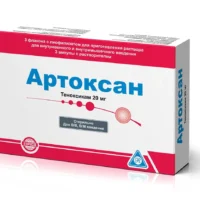Description
Ibunorm Capsules 200 mg. №10
Ingredients:
Each capsule contains 200 mg of ibuprofen.
Mechanism of Action:
Ibuprofen, the active ingredient in Ibunorm capsules, is a nonsteroidal anti-inflammatory drug (NSAID) that works by inhibiting the production of prostaglandins, which are chemicals in the body that cause pain and inflammation.
Pharmacological Properties:
Ibuprofen exerts its analgesic, anti-inflammatory, and antipyretic effects by blocking the enzyme cyclooxygenase (COX), thereby reducing the production of prostaglandins involved in the inflammatory process.
Indications for Use:
Ibunorm capsules are indicated for the relief of mild to moderate pain, inflammation, and fever in conditions such as arthritis, menstrual cramps, and headaches.
Contraindications:
Do not use Ibunorm capsules if you have a history of gastrointestinal bleeding, peptic ulcers, renal impairment, or hypersensitivity to ibuprofen or other NSAIDs.
Side Effects:
- Gastrointestinal: risk of ulcers, bleeding
- Renal: risk of kidney impairment
- Cardiovascular: increased risk of heart attack or stroke
Usage Instructions:
The recommended dosage is one capsule every 4 to 6 hours as needed for pain relief. Swallow the capsule whole with a full glass of water. Do not crush or chew the capsule.
Benefits Compared to Analogues:
Ibunorm capsules offer fast-acting pain relief with a lower risk of gastrointestinal side effects compared to other NSAIDs.
Suitable Patient Groups:
Ibunorm capsules are suitable for adults, including the elderly, for short-term use in managing pain and inflammation.
Storage Conditions and Shelf Life:
Store Ibunorm capsules in a cool, dry place away from direct sunlight. Keep out of reach of children. The shelf life of Ibunorm capsules is typically 2 years.
Packaging Description:
Ibunorm capsules are available in blister packs of 10 capsules each.
Clinical Evidence and Proven Effectiveness:
Clinical trials have shown that Ibunorm capsules provide effective pain relief in various conditions. Studies have demonstrated the efficacy of ibuprofen in relieving pain and reducing inflammation, making Ibunorm a trusted choice for pain management.





